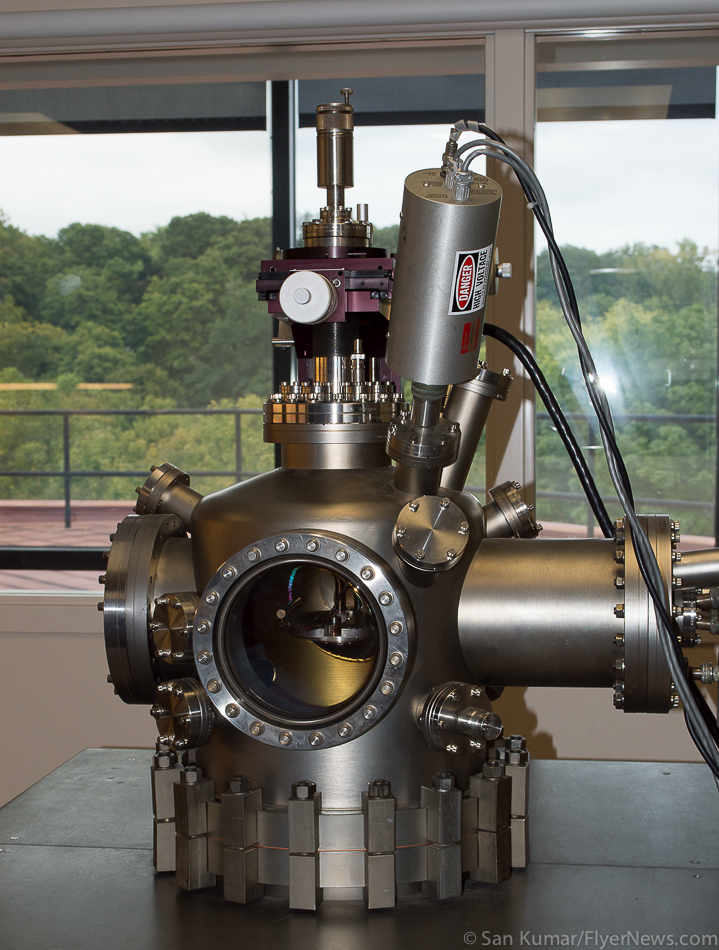UDRI executive director steps down after 21 years
By: Byron Hoskinson – Staff Writer
Lately, the University of Dayton Research Institute’s directors have been as dynamic as the turbine engines in the institute’s new propulsion systems.
John Leland has been appointed interim vice president for research and executive director of UDRI, effective Oct. 16, according to a Sept. 18 email sent from university president Dan Curran to faculty and staff.
Leland will continue serving as associate vice president for research and director of UDRI until the departure next month of Mickey McCabe, the university’s current vice president for research and executive director of UDRI, research institute officials said.
McCabe will retire from UDRI after 21 years at the institute, the last nine of which he served as executive director. He will leave UD for the University of Texas at Arlington Research Institute, which has recruited him to be its executive director, according to a Sept. 2 email from Curran to faculty and staff.
In his Sept. 18 email, Curran lauded Leland as being instrumental in many of the major developments UDRI has undergone in recent years.
“[Leland] successfully lobbied the state of Ohio to allow UD to compete in its Third Frontier Project, which resulted in more than $50 million in awards,” Curran wrote.
Ohio Third Frontier Project contracts now make up more than 15 percent of all research funding at UD, according to the UDRI website.
Curran said Leland was “a key contributor” to the development of the GE Aviation Electrical Power Integrated Systems Center, a $51 million, 138,000-square-foot electrical power lab and office building built on UD’s river campus.
Curran also said Leland was crucial in “developing the initial relationships with GE and acquiring $7.6 million in state support for the project.”
Leland said he joined UDRI in October 2000 as director of technology partnerships and was responsible for the protection and licensing of the university’s intellectual property, including its patents.
A rapid series of promotions saw Leland rise through the administrative ranks, becoming head of the institute’s materials engineering division in 2003 and associate director for research operations in 2004 before being appointed as director the following year, according to Dayton Daily News.
Most recently, Leland accepted the additional role of associate vice president of research in 2013, UDRI officials said.
Leland said he spent his early career at Wright-Patterson Air Force Base, where he worked as a researcher for 16 years.
At WPAFB, Leland worked on the Propulsion Directorate Project, leading a research team in developing lasers and high-powered microwaves for future aircraft, according to an October 2000 UDRI news release.
Immediately prior to his UD career, from 1999-2000, Leland worked as a Congressional science fellow in Washington, D.C., according to the UDRI release.
Leland’s fellowship was sponsored by the American Society of Mechanical Engineers, and, during that year, he “developed legislation and advised U.S. Rep. Tony Hall, D-Dayton, on science and technology issues,” according to the release.
Leland said the latest quarter of the 58-year-old institute’s life, those 14.5 years since his initial hiring, has borne dramatic change for UDRI and the UD community as a whole.
Specifically, developments in the university’s research arm have visibly impacted the student body through the career opportunities and research experiences made available by student collaborations with UDRI, Jason Eckert, director of career services, said.
“UDRI has so many wonderful connections,” Eckert said. “It’s a great source of research experience.”
“Research areas have grown and morphed,” Leland said of the institute’s long-term development. “We’ve gotten more involved in non-defense industry…and [there’s been] a surge of research in the fields of biology and engineering,” he said.
The research institute has also been a leader in sustainable engineering.
This year, a team of UDRI researchers have been contracted by the American Chemistry Council to develop new types of materials for constructing greener vehicles, according to an Aug. 8 Dayton Business Journal article.
Susan Hill, UDRI group leader for structures and materials evaluation, said the research team aims to construct more lightweight structures, like the body frames of cars, from composite materials and fiber-reinforced polymers to lessen environmental impact and meet new fuel-efficiency standards.
“A revolution is coming to the auto industry, by way of fiber-filled polymers and composites,” Hill said. “[It] will open up the landscape for automobile ‘light-weighting’ without sacrificing vehicle safety.”
Eckert said he has noticed a marked increase in the number of students inquiring about “green careers.”
He said having a nationally-competitive research institute on campus provides opportunities that students from other universities likely will never have and allows UD students a familiarity with professional research that is wholly advantageous to their careers.
“Students shouldn’t take the research institute for granted,” Eckert said.


